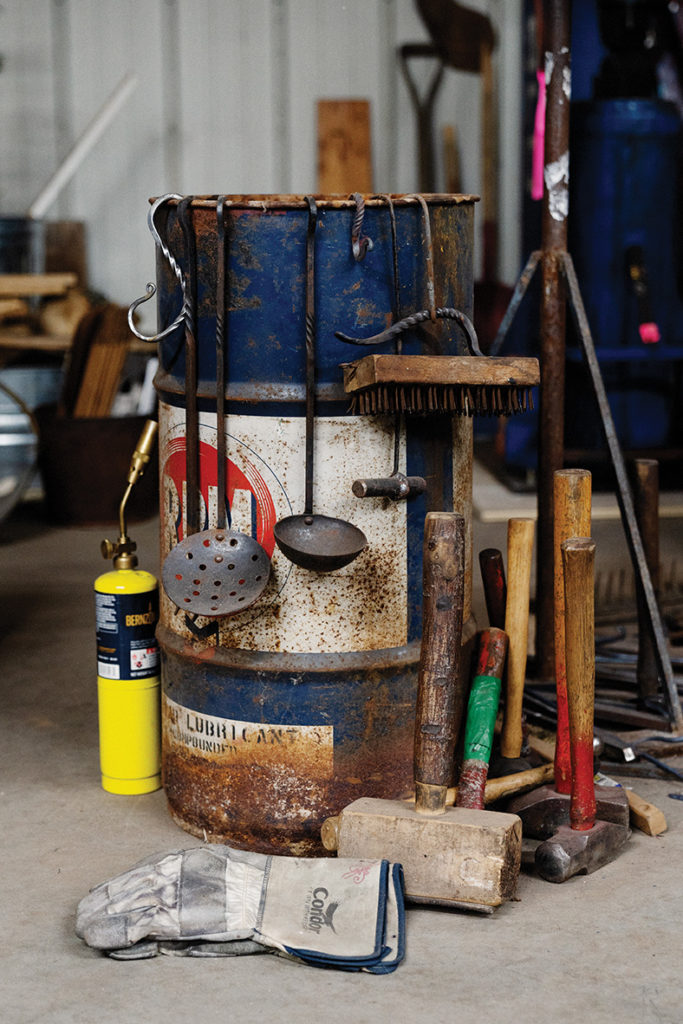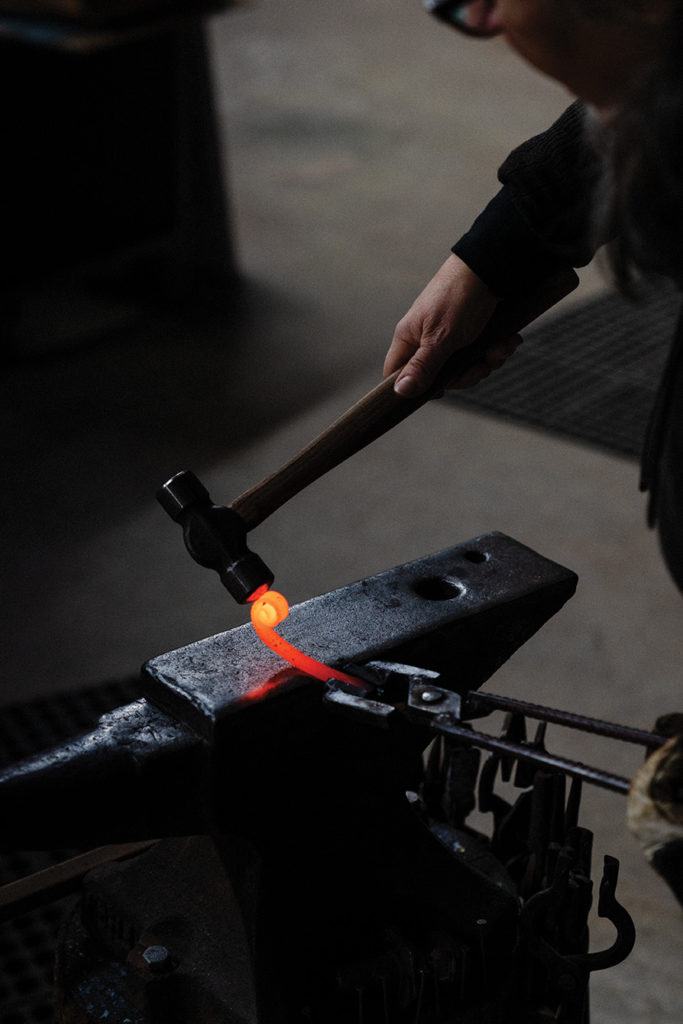The Artist Bringing Life to a Former Factory in Wilton
Vera Johnson’s transformation of an abandoned canning factory into a studio, classroom, and community space represents a new start for the artist and the building.

The Artist Bringing Life to a Former Factory in Wilton
Vera Johnson’s transformation of an abandoned canning factory into a studio, classroom, and community space represents a new start for the artist and the building.
By Amber Kapiloff
Photography by Tara Rice
Issue: March/April 2022
At first glance, the bright teal building of the W.S. Wells and Son canning factory might have seemed out of place on a small road in a small town in Maine. But at a closer look, the factory was the quintessential operation of a hardworking rural Maine family. Its history spanned four generations; it was born of hard times and the need to make ends meet, and its success was founded on the hidden bounty of the surrounding woods and fields. For more than three decades, this factory was a supplier of canned fiddleheads and dandelion greens—one of very few, if not the only one, in the country. Under the label Belle of Maine, the relatively tiny Wilton factory could hardly keep up with orders. W.S. Wells and Son paid hundreds of locals to bring freshly picked fiddleheads to the dooryard of its teal factory every spring.
As is often the case in Maine, the business’s success relied on a unique combination of people, place, Yankee ingenuity, and open doors.
The Wells family kept the factory running for more than 135 years, sending out tinned fiddle-heads and greens since the 1960s after making the switch from canned beans. The factory closed in the early 2000s, forcing local foragers to sell their bounties to other businesses or at roadside stands from the backs of trucks. The giant teal building that once clanged and thudded and spewed with life suddenly fell silent, and the community that gathered around it dispersed.
Until recently.

Artist Vera Johnson bought the former factory last winter and has been steadily stoking its fire back to life. She may not be canning the tight swirls of budding ferns, but she is building her business around their symbolism: new beginnings. “I just love how things fall together,” she says. “I’ve been making fiddleheads and ferns, long before I found the Belle, out of clay, steel, paint, you name it. There’s something symbolic about that. That unfurling, the new life. I’ve been fascinated by them all this time, and now I’m here, in this factory.”
Johnson moved to Maine from Washington state five years ago. While some people come to Maine seeking a rustic, romantic change in lifestyle, Johnson came to Maine to heal. Within a span of six years, she had lost her mother to a sudden cancer, navigated a messy divorce, and dealt with an even messier fraudulent foreclosure. “When I moved here, I was coming off six years of high-adrenaline anxiety and trauma. Maine was a soft place to land, where I could just be me,” she says.
It may not have been a romantic move that brought her to Maine, but Johnson has since established loving roots. Her store in downtown Farmington, Vera’s Iron and Vine, brings together more than 50 Maine makers who sell their pieces to an often jam-packed store of shoppers. She also has established a dedicated following of creatives who sign up for the workshops and classes that she first ran out of her home.


Johnson says she is the “show me what to do and then get out of the way” type of learner; after years of welding, she’s perfected her craft and can often be found in the middle of a commission or personal project. 
The fire, the tools, and the Belle Creative Arts Center all allow Johnson to do what she does best.
To know Johnson is to be a part of something bigger than oneself. Rather than keeping acquaintances, Johnson keeps people employed or keeps them grounded or keeps them in the loop of her constantly moving world. When people sign up for a bracelet-making class, they end up making five friends in the process. When they stop into her store, Vera’s Iron and Vine, for a gift, she may end up clearing space on the shelf for their own homemade product. To be caught in Johnson’s wake is to be taught how to be an active part of your community. Whether it’s absorbing new skills next to someone you just met or leaning on that person through a tough time, Johnson draws people together and strengthens the communities around her.
Johnson’s creative outlets have become her basis for figuring out life. Channeling her trauma through art is often the only way she is able to process all that she’s been through, and it has become her most valuable skill to pass on to others. Over the years, Johnson has realized that she frequently finds a certain type of person on her doorstep—the type who needs to engage with a tool or a raging fire to work something out. “The truth is, you’re in a relationship with that material,” she says. “And you have to listen to it, watch it, and feel it. And that doesn’t come naturally to a lot of people.”

Johnson was recently hired by Haystack Mountain School of Crafts in Deer Isle to teach a blacksmithing course next summer. She says at first she doubted her qualifications, but with some encouragement from the school, she’s looking forward to leading a class in her preferred self-directed style. “I don’t learn from a book. I can’t sit in a classroom. I’m the ‘show me what to do and then get out of the way’ type,” Johnson says. “I told them I can’t teach them how to make a wine rack, but I can teach the fundamentals and let people explore from there. And that’s my favorite way to teach.”
Now that Johnson has a home base at the Belle, she has taken on apprentices, offers a wider range of classes and workshops, and uses the open space to work on her own art. Johnson plans to open the space to an even bigger community this summer, with black-smithing meetups, concerts, and open studio events. The Belle will once again open its doors and dooryard to locals and newcomers alike.
“I don’t think I even understand the fullness of this potential yet,” Johnson says. “For me, this is coming out on the other side. It’s wings. You know, the chrysalis and all that. The butterfly. This is me flying.”

This teal factory on a back road in Wilton sat silent for nearly 20 years until Vera Johnson discovered the listing. 
After a 2019 propane explosion in Farmington killed a member of the fire department, Johnson found herself compelled to not only memorialize the incident but also offer a place of healing for all those impacted; the result was a sound garden using vintage fire extinguishers repurposed into chimes.

Johnson always adds a unique twist to commissions, including this fiddlehead-esque swirl detail. 
Johnson has already filled the space with endless activity through apprenticeships, community events, and workshops.
Read More:
- The Immortal Life of Holly Meade

- “Beyond the Brick” Brings Maine-Made Art and Music to Life

- Watercolor Painter Abe Goodale Traces His Roots on 700 Acre Island

- Shifting Dynamics Through the Power of Theater


